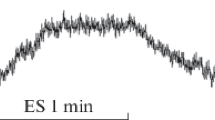Abstract
Objective
Nitric oxide synthesized from L-arginine via the nitric oxide synthase enzyme family is the main regulatory molecule in many physiological systems. The level of nitric oxide can now be measured in tissues by a direct real-time amperometric method. The effect of electrical stimulation of the upper cervical spine on the arteries that supply the brain and upper extremities has been established by experimental studies, and thus it has begun to be used in clinical practice to increase blood flow in the brain and the peripheral vascular system. The mechanism of this effect is still a subject of research. This is the first report of real-time nitric oxide measurement in living brain and dermal tissue during electrical stimulation of the upper cervical spine.
Methods
Using the amperometric method, nitric oxide levels in frontal subcortical and front foot skin were measured before, during and after electrical stimulation of the upper cervical spine in three groups of rabbits that received infusions of saline solution, 7-aminoguanidine or atropine.
Results
By electrical stimulation, tissue nitric oxide levels increased significantly and remained increased during stimulation in the brain and skin. The nitric oxide levels dropped back to normal value 1 min after stimulation was turned off.
Conclusion
The results we obtained have showed that real-time nitric oxide could also be measured by an amperometric method in living tissues like brain. The effect of stimulation on nitric oxide levels of living tissues disappears immediately when the stimulation is turned off.



Similar content being viewed by others
References
Archer S (1993) Measurement of nitric-oxide in biological models. FASEB J 7:349–360
Borsani E, Giovannozzi S, Boninsegna R, Rezzani R, Labanca M, Tschabitscher M, Rodella LF (2010) Nitroxidergic system in human trigeminal ganglia neurons: a quantitative evaluation. Acta Histochem 112:444–451
Brendt DS, Synder SH (1992) Nitric oxide, a novel neuronal messenger. Neuron 8:3–11
Clavo B, Robaina F, Catalá L, Pérez JL, Lloret M, Caramés MA, Morera J, López L, Suárez G, Macías D, Rivero J, Hernández MA (2004) Effect of cervical spinal cord stimulation on regional blood flow and oxygenation in advanced head and neck tumors. Ann Oncol 15:802–807
Clavo B, Robaina F, Montz R, Carames MA, Otermin E, Carreras JL (2008) Effect of cervical spinal cord stimulation on cerebral glucose metabolism. Neurol Res 30:652–654
Croom JE, Foreman RD, Chandler MJ, Barron KW (1997) Cutenous vasodilation during dorsal column stimulation is mediated by dorsal roots and CGRP. Am J Physiol 272:950–957
Croom JE, Foreman RD, Chandler MJ, Koss MC, Barron KW (1997) Role of nitric oxide in cutenous blood flow increase in the rat hindpaw during dorsal column stimulation. Neurosurgery 40:565–571
Doba N, Reis DJ (1972) Changes in regional blood flow and cardiodynamics evoked by electrical stimulation of the fastigial nucleus in the cat and their similarity to orthostatic reflexes. J Physiol 227:729–747
Göksel HM, Karadağ Ö, Turaçlar U, Taş F, Öztoprak İ (2001) Nitric oxide synthase inhibition attenuates vasoactive response to spinal cord stimulation in an experimental cerebral vasospasm model. Acta Neurochir (Wien) 143(4):383–391
Iadecola C (1997) Bright and dark sides of nitric oxide in ischemic brain injury. Trends Neurosci 20:132–139
Kanda K, Mitchell JA, de Nucci G, Vane JR (1989) Simultaneous measurement of endothelium-derived relaxing factor by bioassay and guanilate cyclase stimulation. Br J Pharmacol 98:630–636
Karadağ O, Eroğlu E, Gürelik M, Göksel HM, Kiliç E, Gültürk S (2005) Cervical spinal cord stimulation increases cerebral cortical blood flow in an experimental cerebral vasospasm model. Acta Neurochir (Wien) 147:79–84
Kiechle FL, Malinsky T (1993) Nitric oxide; biochemistry, pathophysiology and detection. Am J Clin Path 100:567–575
Lee JY, Huang DL, Keep R, Sagher O (2008) Effect of electrical stimulation of the cervical spinal cord on blood flow following subarachnoid hemorrhage. J Neurosurg 109:1148–1154
Linderoth B, Herregodts P, Meyerson BA (1994) Sympathetic mediation of peripheral vasodilatation induced by spinal cord stimulation. Animal studies of the role of cholinergic and adrenergic receptor subtypes. Neurosurgery 35:711–719
Magazine HI (1995) Detection of endothelial cell-derived nitrice oxide: current trends and future directions. Adv Neuroimmunol 5:479–490
Meglio M, Cioni B, Visocchi M, Nobili F, Rodriguez G, Rosadini G, Chiappini F, Sandric S (1991) Spinal cord stimulation and cerebral hemodynamic. Acta Neurochir (Wien) 111:43–48
Nagano T (1999) Practical methods for detection of nitric oxide. Luminescence 14:289–290
Patel S, Huang DL, Sagher O (2003) Sympathetic mechanisms in cerebral blood flow alterations induced by spinal cord stimulation. J Neurosurg 99:754–761
Russel RJ (1998) Use of arginin analogs as inhibitors of nitric oxide synthase in rat aortic rings. In: Titheradge MA (ed) Methods in molecular biology. Humana Press, New Jersey
Tanaka S, Komori N, Barron KW, Chandler MJ, Linderoth B, Foreman D (2004) Mechanisms of susteined cuteneous vasodilatation induced by spinal cord stimulation. Autonom Neurosci 114:55–60
Visocchi M, Argiolas L, Meglio M, Cioni B, Basso PD, Rollo M, Cabezas D (2001) Spinal cord stimulation and early experimental cerebral spasm: the “functional monitoring” and the “preventing effect”. Acta Neurochir (Wien) 143:177–185
Wu M, Komori N, Qin C, Farber JP, Linderoth B, Foreman R (2006) Sensory fibers containing vanilloid receptor-1 (VR-1) mediate spinal cord stimulation-induced vasodilatation. Brain Res 30:177–184
Zang XJ, Cardoso L, Broderick M, Fein H, Davies IR (2000) Novel calibration method for nitric oxide microsensors by stoichiometrical generation of nitric oxide from SNAP. Electroanalysis 12:425–428
Acknowledgements
This work is supported by the Scientific Research Project Fund of Cumhuriyet University under the project number T275. We thank Mrs. Ziynet Cinar for her assistance in the statistical analysis.
Conflicts of interest
None.
Author information
Authors and Affiliations
Corresponding author
Rights and permissions
About this article
Cite this article
Özüm, Ü., Akyol, M., Balaban, H. et al. Effect of cervical spinal cord electrical stimulation on nitric oxide levels in brain and dermal tissues: an evaluation using by real-time nitric oxide measurement. Acta Neurochir 154, 1641–1646 (2012). https://doi.org/10.1007/s00701-012-1331-3
Received:
Accepted:
Published:
Issue Date:
DOI: https://doi.org/10.1007/s00701-012-1331-3




